Join Our Giraffe Conservation Program to Protect These Majestic Animals.
Giraffe Conservation Program
The program focuses on a range of conservation efforts that are designed to protect giraffes and their habitats. Some of the key areas of focus include research, education, habitat conservation, and policy advocacy. Through these efforts, the program aims to raise awareness about the challenges facing giraffes and to promote the implementation of effective conservation strategies.
One of the primary objectives of the Giraffe Conservation Program is to conduct research to better understand the biology and behavior of giraffes. This research is crucial in developing effective conservation strategies that can help protect giraffes and their habitats. The program also aims to increase public awareness about the importance of giraffes and their role in maintaining healthy ecosystems.
In addition to research, the program also focuses on habitat conservation. This involves working with local communities to promote sustainable land use practices that support giraffe populations. The program also supports the creation of protected areas and the implementation of policies that help to reduce the impact of human activities on giraffes and their habitats.
Education is another critical component of the Giraffe Conservation Program. The program works to raise awareness among local communities, policymakers, and the public about the importance of giraffes and the challenges they face. By increasing public awareness, the program aims to build support for conservation efforts and promote sustainable practices that protect giraffes and their habitats.
The Giraffe Conservation Program also engages in policy advocacy to promote giraffe conservation at the local, national, and international levels. The program works with policymakers to develop and implement policies that support giraffe conservation, including habitat protection, anti-poaching measures, and sustainable land use practices.
Overall, the Giraffe Conservation Program is an essential initiative that is working to protect and conserve giraffes and their habitats. By engaging in research, education, habitat conservation, and policy advocacy, the program is helping to raise awareness about the importance of giraffes and promote effective conservation strategies. With continued support, the Giraffe Conservation Program has the potential to make a significant impact in the effort to protect giraffes and ensure that they continue to thrive in their natural habitats for generations to come.
Giraffe Habitat
Giraffes are found in different habitats across Africa, including savannas, woodlands, and forests. The savanna is the most common habitat for giraffes, as it provides a wide expanse of grasslands for grazing, and trees for shelter and browsing. In the savanna, giraffes can spot predators from far away due to their height, giving them an advantage in avoiding danger. Additionally, giraffes are browsers, and the savanna has an abundance of trees that provide leaves, shoots, and fruits that they feed on.
Woodlands are also a vital habitat for giraffes, as they provide shade and cover from the hot sun, which is crucial in hot and arid areas. Giraffes in woodlands browse on leaves, shoots, and fruits from trees such as acacias, which have long spines to deter herbivores. The giraffes’ long tongue and necks enable them to reach these hard-to-reach trees to obtain food.
Forests are the least common habitats for giraffes, as they are not adapted to this environment. Forests are dense, with limited visibility, and the vegetation is mainly for understory browsing, which makes it challenging for giraffes to navigate. However, some giraffe subspecies, such as the West African giraffe, are adapted to forest habitats and can be found in the dense forests of West Africa. In these habitats, giraffes feed on leaves, fruits, and flowers from the forest canopy.
The survival of giraffes in their habitats depends on the availability of water sources. Giraffes can survive long periods without water, but they must drink water when available to maintain their health. Therefore, giraffes move in search of water sources, and some populations have adapted to drinking water from seasonal rivers or waterholes. These water sources attract other animals and predators, which make it essential for giraffes to be alert and cautious when drinking.
Human activities such as poaching, habitat loss, and human-wildlife conflicts pose a significant threat to giraffes and their habitats. Therefore, conservation efforts are critical to protecting and preserving these habitats. Conservation programs aim to promote sustainable land use practices, establish protected areas, and manage human-wildlife conflicts to ensure that giraffes and other wildlife can thrive in their natural habitats.
In conclusion, giraffes are found in a variety of habitats across Africa, including savannas, woodlands, and forests. These habitats provide giraffes with food, water, shelter, and security from predators. The survival of giraffes in their habitats depends on their adaptations to their environment, and the conservation of these habitats is crucial in ensuring the survival of giraffe populations.
Giraffe Diet
The giraffe diet consists primarily of leaves, flowers, and fruits from trees and shrubs. Giraffes are able to consume these plants by using their long necks to reach high into the trees. They are also able to use their long tongues, which can extend up to 18 inches, to wrap around branches and pull leaves into their mouths.
One of the most interesting aspects of the giraffe diet is their ability to eat thorny plants without injuring themselves. Giraffes have thick, tough lips and a specialized digestive system that allows them to break down and process the thorns and other tough plant material. They also have a four-chambered stomach that allows them to extract as much nutrition as possible from their food.
Another important aspect of the giraffe diet is their need for water. While giraffes can survive for long periods of time without water, they do need to drink regularly to maintain their health. Giraffes typically obtain water from rivers, lakes, and other sources that are close to their feeding grounds.
In addition to their unique diet, giraffes also have a specialized feeding behavior. They typically spend up to 16 hours a day feeding, and they move slowly and deliberately from tree to tree. They are also known to "browse" on several different types of trees and shrubs, which helps to ensure that they have a varied diet.
Overall, the giraffe diet is an amazing example of how animals can adapt to their environment. By developing specialized physical and behavioral traits, giraffes are able to thrive on a diet of tough, thorny plants that would be difficult for most other animals to consume. As a result, they are able to maintain their iconic appearance and unique lifestyle in some of the harshest environments on Earth.
Giraffe Anatomy
Skeletal Structure:
Giraffes are the tallest mammals on Earth, with males reaching up to 18 feet in height. Their unique anatomy allows them to reach high into trees to feed on leaves that other herbivores can't reach. One of the most notable features of the giraffe is their long neck, which can measure up to 6 feet in length. Contrary to popular belief, giraffes do not have more neck bones than other mammals; they have the same number of cervical vertebrae (seven) as most mammals, including humans. However, each individual vertebrae can measure up to 10 inches in length, providing giraffes with the necessary flexibility to bend their necks and reach high branches. In addition to their long necks, giraffes also have long legs that help them to run at speeds of up to 35 miles per hour.
Muscular System:
Giraffes have powerful muscles that allow them to move their heavy bodies with ease. Their muscular system is specifically designed to support their long necks and to provide the necessary strength to run quickly. Their leg muscles are some of the most powerful in the animal kingdom, and they are capable of carrying the weight of the giraffe's body as it runs.
Circulatory System:
Giraffes have a unique circulatory system that allows them to maintain blood flow to their brains, even when they are in an upright position. Their hearts are incredibly strong, weighing up to 25 pounds, and they can pump up to 16 gallons of blood per minute. In order to maintain blood flow to their brains, even when their heads are elevated, giraffes have a complex network of blood vessels in their necks that regulate blood pressure.
Respiratory System:
Giraffes have a respiratory system that is adapted to their high-altitude environment. They have large lungs that can hold up to 12 gallons of air, allowing them to take in more oxygen with each breath. Their long necks also play a role in their respiratory system, as they allow giraffes to inhale more air per breath than other mammals.
Digestive System:
Giraffes are herbivores, and their digestive system is specifically adapted to processing leaves. They have a four-chambered stomach that allows them to break down tough cellulose fibers found in leaves. Giraffes also have a long, prehensile tongue that can measure up to 18 inches in length, allowing them to strip leaves from trees with ease.
In conclusion, the anatomy of the giraffe is a marvel of evolution, perfectly adapted to its unique environment. From their long necks to their powerful muscles and complex circulatory system, every part of the giraffe's anatomy has evolved to support its towering stature and remarkable abilities.
Giraffe Behavior
Social Structure:
Giraffes are social animals, and they typically live in loose groups called towers or journeys. These groups can vary in size, with some consisting of just a few individuals while others may have up to 20 members. Male giraffes are typically solitary, but they may form brief associations with other males during mating season.
Communication:
Giraffes communicate with each other using a variety of methods, including vocalizations, body language, and scent marking. Their vocalizations include grunts, snorts, and moans, and they can also make loud coughing sounds. Giraffes also communicate through visual signals, such as the position of their ears and the movements of their heads and tails. They also use scent marking to communicate with other giraffes. Male giraffes are known to engage in a behavior called "necking," where they use their necks to hit each other in a display of dominance.
Feeding Behavior:
Giraffes are herbivores, and they spend most of their day feeding on leaves, buds, and flowers from trees and bushes. They have long, prehensile tongues that can reach up to 18 inches in length, allowing them to grasp and strip leaves from tree branches. Giraffes also have specialized digestive systems that allow them to break down the tough cellulose fibers found in leaves.
Reproduction:
Giraffes are polygamous, with males competing for the attention of females during mating season. During courtship, males engage in displays of dominance and aggression, such as necking and sparring. Female giraffes give birth to a single calf, which can weigh up to 150 pounds at birth. Calves are born with a fully formed pair of horns called ossicones, which lie flat on their heads and become upright within a few days.
Movement:
Despite their size, giraffes are graceful and agile animals. They can run at speeds of up to 35 miles per hour, and their long legs allow them to take large strides. Giraffes also have a unique gait that involves moving both legs on one side of their body at the same time, which gives them a swaying motion as they walk.
In conclusion, giraffes are fascinating animals with a variety of interesting behaviors. From their social structures to their communication methods, feeding behavior, reproduction, and movement, every aspect of their behavior is intriguing and worthy of further exploration.
Giraffe Conservation
Habitat Loss:
One of the biggest threats to giraffe populations is habitat loss. Giraffes rely on savanna and woodland habitats for food and shelter, but these habitats are being destroyed at an alarming rate due to human activities such as agriculture, mining, and urbanization. Conservation efforts to protect giraffes include habitat restoration and creation, which involves restoring degraded habitats and creating new ones to provide additional space for giraffes to roam.
Poaching:
Giraffes are not typically targeted by poachers for their meat or hides, but they are often killed for their tails, which are highly valued as a status symbol and for their supposed medicinal properties. To combat poaching, conservation organizations are working to increase public awareness of the issue, strengthen law enforcement efforts, and provide alternative livelihoods for people who rely on poaching as a source of income.
Human-Wildlife Conflict:
As human populations grow and expand into areas where giraffes live, conflicts can arise as giraffes compete for resources with livestock and crops. To mitigate these conflicts, conservation organizations are working with local communities to develop strategies that allow humans and giraffes to coexist peacefully, such as using alternative grazing areas and crop protection measures.
Conservation Efforts:
There are many organizations working to protect giraffes and their habitats. The Giraffe Conservation Foundation (GCF) is one such organization that works to ensure the long-term survival of giraffes in the wild. The GCF uses a variety of approaches to conserve giraffes, including conducting research to better understand their biology and behavior, working with local communities to develop conservation strategies, and engaging with policymakers to advocate for giraffe protection.
Another organization, the African Wildlife Foundation (AWF), is working to protect giraffes by conserving their habitats and promoting sustainable land use practices. The AWF works with local communities to establish protected areas and wildlife corridors, and it also supports anti-poaching efforts to prevent giraffes and other wildlife from being killed for their body parts.
Conclusion:
Giraffes are an important part of the African ecosystem and their conservation is crucial for the health of the ecosystem as a whole. The decline in giraffe populations is a serious issue, but there are many organizations and individuals working to protect these magnificent animals. Through habitat restoration, anti-poaching efforts, and community engagement, we can ensure that giraffes continue to thrive in the wild for generations to come.
Giraffe Predators
Lions:
Lions are perhaps the most well-known predator of giraffes. While lions do not typically hunt adult giraffes, they will go after young or weak individuals. Lions often target giraffe calves, using their strength and sharp claws to take down these vulnerable prey. In addition to lions, other big cats such as leopards and cheetahs may also prey on giraffes.
Hyenas:
Hyenas are another predator that poses a threat to giraffes, especially young or injured individuals. Hyenas are known for their scavenging abilities, but they will also hunt live prey if the opportunity arises. They are highly skilled hunters and can take down large prey with their powerful jaws.
Crocodiles:
While giraffes are primarily terrestrial animals, they may also venture into water to drink or cross rivers. When they do, they may be at risk from crocodiles, which are skilled hunters both in and out of the water. Crocodiles are powerful predators with sharp teeth and strong jaws, and they can take down prey much larger than themselves.
Humans:
Unfortunately, humans are also a major threat to giraffes. Habitat loss, poaching, and human-wildlife conflict all contribute to the decline of giraffe populations. In some areas, giraffes are hunted for their meat or for their tails, which are highly valued as a status symbol. In other areas, they may be killed in retaliation for crop or livestock damage.
Defense Mechanisms:
Despite their size, giraffes have a number of defense mechanisms that they use to protect themselves from predators. Their long legs and powerful kicks can be deadly to predators such as lions or hyenas. Giraffes can also use their long necks to deliver a powerful blow with their heads, and they may use their horns to defend themselves as well.
Giraffes are also highly alert and can detect potential predators from a distance. They have excellent eyesight and can see for long distances thanks to their height. In addition, they have a keen sense of smell and can detect the scent of predators from far away.
Conclusion:
While giraffes may seem like invincible giants, they face a number of predators in the wild. Lions, hyenas, crocodiles, and humans all pose a threat to their survival. Despite this, giraffes have a number of defense mechanisms and are highly adapted to their environments. Through conservation efforts, we can work to protect giraffes and their habitats, ensuring that these magnificent animals continue to thrive in the wild.
Giraffe Species
Northern Giraffe (Giraffa camelopardalis)
The Northern Giraffe is the tallest subspecies of giraffe and is found in several countries in Africa, including Chad, Cameroon, and Uganda. This subspecies is known for its pale coat with irregular spots and the distinct white lines that separate the spots. The Northern Giraffe has three distinct subspecies: the Kordofan, Nubian, and West African Giraffe.
Southern Giraffe (Giraffa giraffa)
The Southern Giraffe is found in several countries in southern Africa, including South Africa, Namibia, and Zimbabwe. This subspecies has a darker coat with small, more irregular spots. The Southern Giraffe also has three distinct subspecies: the Angolan, South African, and Namibian Giraffe.
Masai Giraffe (Giraffa tippelskirchi)
The Masai Giraffe is found in Tanzania and Kenya and is known for its large, irregular spots. This subspecies has a distinctive jagged pattern to its spots, which are often described as looking like puzzle pieces. The Masai Giraffe has a long, dark tongue that it uses to reach leaves from trees.
Reticulated Giraffe (Giraffa reticulata)
The Reticulated Giraffe is found in northern Kenya, Somalia, and Ethiopia. This subspecies is known for its large, polygonal spots that are evenly spaced and have no white lines in between. The Reticulated Giraffe has a narrower head than other subspecies, and its coat is a lighter shade of brown.
Each subspecies of giraffe has adapted to its specific environment, and their distinct coat patterns help to camouflage them in their respective habitats. Despite their differences, all giraffes share certain characteristics, such as their long necks and legs, and their ability to reach leaves and other vegetation high in trees.
Unfortunately, all giraffe subspecies are facing threats to their survival due to habitat loss, poaching, and human-wildlife conflict. Conservation efforts are critical to protecting these majestic animals and ensuring that they continue to thrive in the wild.
Giraffe Reproduction
Mating:
Giraffes are polygamous, meaning that males mate with multiple females. Males will engage in combat with other males to establish dominance and access to females. They use their long necks to deliver powerful blows with their heads, and their legs to deliver powerful kicks. Once a male has established dominance, he will mate with receptive females within his territory.
Females come into estrus, or heat, approximately every two weeks. During this time, they are receptive to mating and will seek out dominant males. Males may follow females for several days, engaging in courtship behavior such as nuzzling and licking.
Gestation:
After mating, the female giraffe undergoes a gestation period of approximately 15 months. During this time, the fetus develops inside the uterus, which is elongated and can measure up to six feet long. Giraffe mothers do not form lasting pair bonds with males and will give birth to their young alone.
Birth:
When it is time to give birth, the mother giraffe will typically move away from the herd and find a secluded spot to deliver her calf. The calf is born in a standing position, with its front legs appearing first, followed by its head and neck. The fall to the ground helps to break the umbilical cord, and the calf can stand and walk within an hour of being born.
Calf Rearing:
Giraffe calves are vulnerable to predators such as lions, hyenas, and leopards, and so they must learn to stand and walk quickly. The mother will nurse her calf for up to a year, during which time the calf will grow rapidly, gaining as much as 3-4 pounds per day. The mother will fiercely protect her young from predators and will even fight off other giraffes if they come too close.
Conclusion:
Giraffe reproduction is a fascinating process that involves courtship, gestation, and birth. While giraffes are polygamous and males must compete for access to females, mothers are fiercely protective of their young and will do everything they can to ensure their survival. Through conservation efforts, we can work to protect giraffes and their habitats, ensuring that these magnificent animals continue to thrive in the wild.
Giraffe Height
Average Height:
The average height of a giraffe is around 16-18 feet (4.8-5.5 meters) for males, and 14-16 feet (4.3-4.8 meters) for females. However, there is significant variation in height between individuals and subspecies, with some individuals reaching heights of up to 19 feet (5.8 meters).
Adaptations for Height:
Giraffes are able to grow so tall thanks to several unique adaptations. One of the most obvious is their long necks, which can measure up to six feet (1.8 meters) in length. The giraffe's neck contains the same number of vertebrae as other mammals, but each individual vertebra is much larger, allowing for greater flexibility and range of motion.
In addition to their long necks, giraffes have long legs that help to elevate their bodies off the ground. This allows them to reach vegetation that is high off the ground, which is important since they are herbivores that rely on leaves, flowers, and fruits for their diet.
Another adaptation that allows giraffes to grow so tall is their unique cardiovascular system. Giraffes have a very large heart, which is capable of pumping blood up to their brain against the force of gravity. They also have a complex network of blood vessels in their necks that helps to regulate blood pressure and prevent blood from pooling in their heads when they bend down to drink water.
Behavioral Factors:
While genetics and physical adaptations play a large role in determining giraffe height, there are also behavioral factors at play. For example, giraffes will often stretch their necks and stand on their hind legs in order to reach higher vegetation. This stretching behavior may help to promote growth and development in their necks.
Conclusion:
Giraffes are the tallest land animals in the world, and their exceptional height is the result of a combination of genetics, physical adaptations, and behavioral factors. Through conservation efforts, we can work to protect these magnificent animals and ensure that they continue to thrive in the wild.
Giraffe Adaptations
Long Neck:
The most obvious adaptation of giraffes is their long necks. While it was previously thought that the necks evolved to help giraffes reach high vegetation, recent studies suggest that they may also have evolved as a result of sexual selection, with males developing longer necks to compete for females. Regardless of the reason for their development, giraffes have an impressive 7 vertebrae in their necks, each measuring up to 10 inches long, and are capable of reaching heights of up to 18 feet (5.5 meters).
Long Legs:
In addition to their long necks, giraffes also have long legs, which allow them to reach high vegetation and run quickly to avoid predators. Their legs are so long that they are taller than many humans when standing on all fours, and they are capable of running at speeds of up to 35 miles per hour (56 kilometers per hour).
Tongue:
Another unique adaptation of giraffes is their tongue, which can measure up to 18 inches (45 centimeters) long. The tongue is prehensile, meaning that it can wrap around branches and strip leaves from them. It is also coated in a tough layer of tissue to protect it from thorns and other sharp objects.
Heart:
Giraffes have a massive heart that weighs up to 25 pounds (11 kilograms) and is capable of pumping up to 16 gallons (60 liters) of blood per minute. This is necessary to pump blood up their long necks to their brains, and to maintain blood pressure when they lower their heads to drink water.
Camouflage:
The coat of a giraffe is covered in a unique pattern of brown spots, which provides excellent camouflage in their natural environment. The pattern is different for each individual, making it easier for other giraffes to recognize them.
Conclusion:
Giraffes are fascinating animals that have evolved many unique adaptations to survive in their environments. From their long necks and legs to their prehensile tongues and massive hearts, these animals are truly one-of-a-kind. Through conservation efforts, we can work to protect giraffes and their habitats, ensuring that they continue to thrive in the wild.
What we can do to save the giraffe
Protect their habitat:
One of the biggest threats to giraffes is habitat loss due to human activities such as deforestation, agriculture, and mining. To save giraffes, we need to protect their natural habitats by creating and enforcing laws that restrict human activities in these areas. We can also work with local communities to promote sustainable land use practices that minimize the impact on giraffe habitats.
Combat poaching:
Poaching is another major threat to giraffes, with their hides and other body parts being sold for use in traditional medicine or as trophies. To save giraffes, we need to strengthen anti-poaching laws and increase enforcement efforts. We can also work with local communities to raise awareness about the importance of protecting giraffes and discourage poaching.
Support conservation efforts:
There are many organizations and initiatives working to save the giraffe, and we can support these efforts through donations, volunteering, and advocacy. Some of the organizations working to save the giraffe include the Giraffe Conservation Foundation, the World Wildlife Fund, and the African Wildlife Foundation.
Address climate change:
Climate change is another major threat to giraffes, with rising temperatures and changing weather patterns affecting their habitats and food sources. To save giraffes, we need to address climate change by reducing greenhouse gas emissions and promoting sustainable practices such as renewable energy and conservation agriculture.
Raise awareness:
Finally, we can all help to save giraffes by raising awareness about their plight and the importance of conservation efforts. We can share information on social media, participate in educational programs, and encourage others to get involved in conservation efforts.
Conclusion:
Giraffes are facing numerous threats to their survival, but with the right actions, we can save them from extinction. By protecting their habitats, combating poaching, supporting conservation efforts, addressing climate change, and raising awareness, we can ensure that giraffes continue to thrive in the wild for generations to come.
Here Is Some FAQ:
Giraffes are known for their towering height, and can grow up to 18 feet tall. This makes them the tallest land animal in the world.
2. What do giraffes eat?
Giraffes are herbivores and primarily eat leaves from trees, especially acacia trees. They can also eat grass and fruit.
3. Do giraffes have any predators?
Despite their large size, giraffes do have predators in the wild. Lions and hyenas are known to hunt giraffes, especially young or weak individuals.
4. How long do giraffes live?
Giraffes can live up to 25 years in the wild, although their lifespan may be shorter in captivity.
5. Are giraffes endangered?
Yes, giraffes are currently listed as a vulnerable species by the International Union for Conservation of Nature (IUCN). Their population has declined by over 30% in the last 30 years due to habitat loss, poaching, and other threats.
6. How do giraffes drink water?
Giraffes have to splay their legs and bend down awkwardly to drink water. This is because their long necks and tall stature make it difficult for them to reach the ground while standing upright. They also have a unique valve system in their necks that prevents them from getting a rush of blood to the head when they bend down.

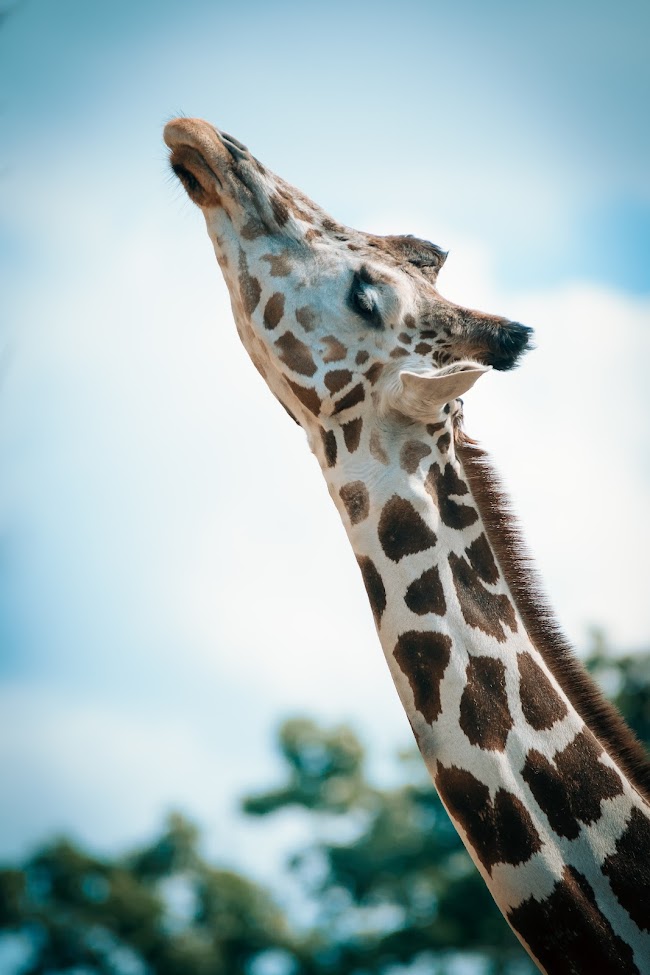




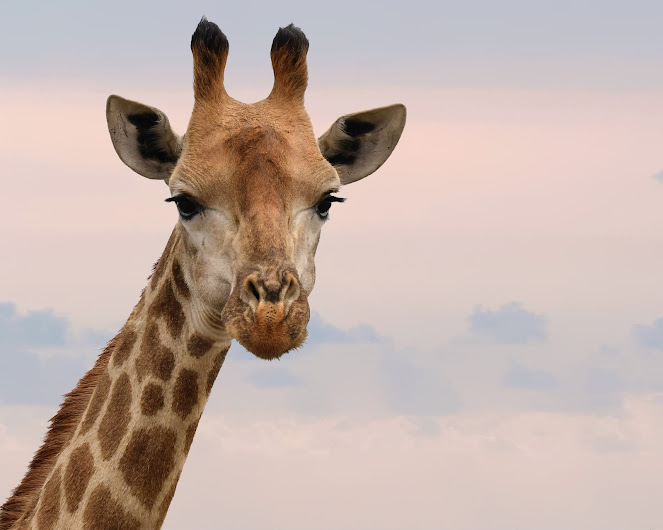
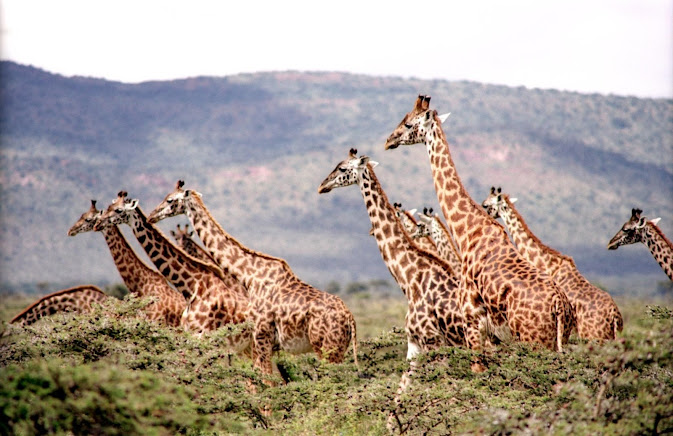

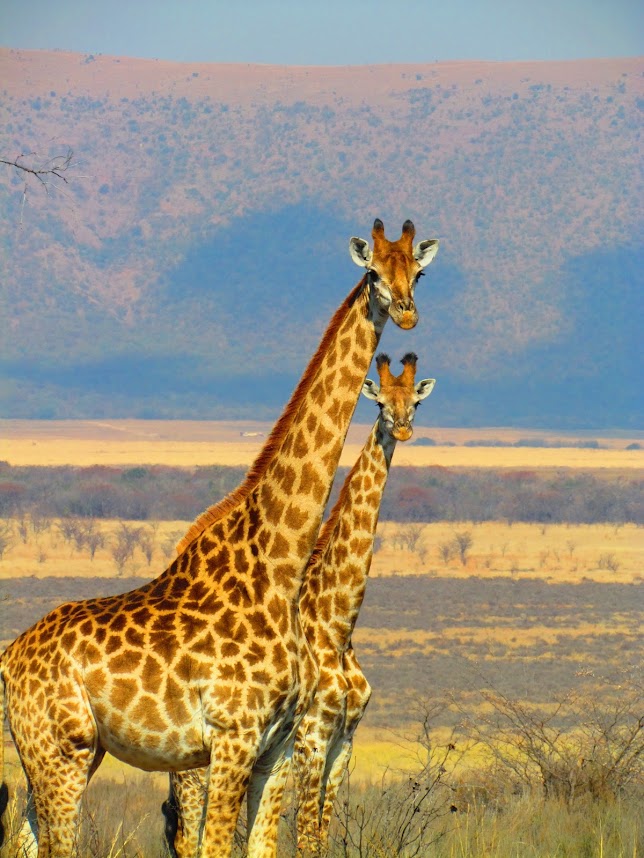


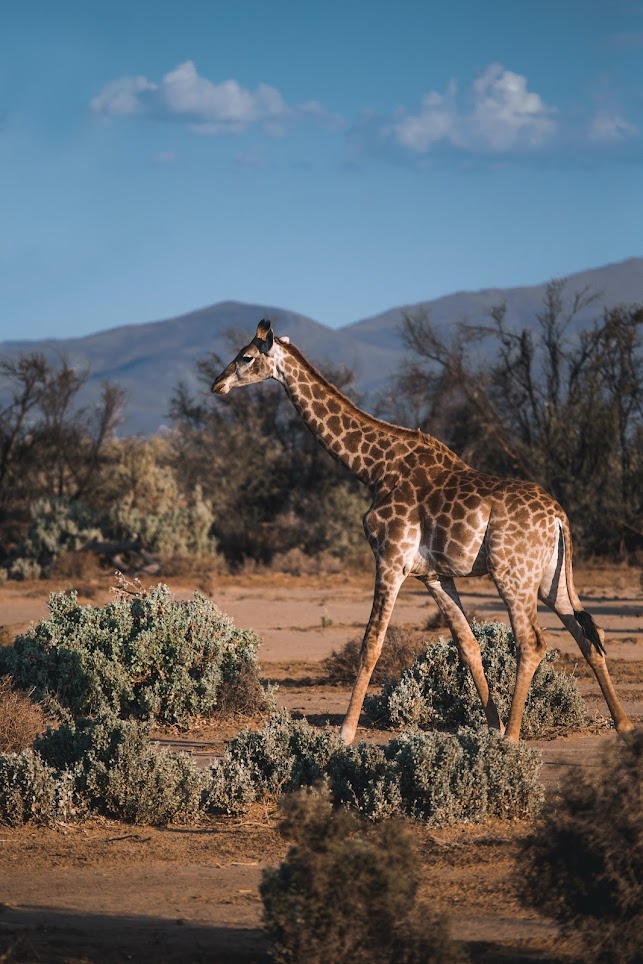



Comments
Post a Comment